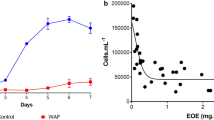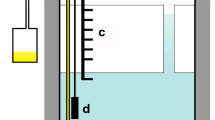Abstract
Exposure of phytoplankton to the water-accommodated fraction of crude oil can elicit a number of stress responses, but the mechanisms that drive these responses are unclear. South Louisiana crude oil was selected to investigate its effects on population growth, chlorophyll a (Chl a) content, antioxidative defense, and lipid peroxidation, for the marine diatom, Ditylum brightwellii, and the dinoflagellate, Heterocapsa triquetra, in laboratory-based microcosm experiments. The transcript levels of several possible stress-responsive genes in D. brightwellii were also measured. The microalgae were exposed to crude oil for up to 96 h, and Chl a content, superoxide dismutase (SOD), the glutathione pool (GSH and GSSG), and lipid peroxidation content were analyzed. The cell growth of both phytoplankton species was inhibited with increasing crude oil concentrations. Crude oil exposure did not affect Chl a content significantly in cells. SOD activities showed similar responses in both species, being enhanced at 4- and 8-mg/L crude oil exposure. Only H. triquetra demonstrated enhanced activity in GSSG pool and lipid peroxidation at 8-mg/L crude oil exposure, suggesting that phytoplankton species have distinct physiological responses and tolerance levels to crude oil exposure. This study indicated the activation of reactive oxygen species (ROS) in phytoplankton under crude oil exposure; however, the progressive damage in cells is still unknown. Thus, ROS-related damage in nucleic acid, lipids, proteins, and DNA, due to crude oil exposure could be a worthwhile subject of study to better understand crude oil toxicity at the base of the food web.







Similar content being viewed by others
References
Agrawal SB (1992) Effects of supplemental U.V.-B radiation on photosynthetic pigment, protein and glutathione contents in green algae. Environ Exp Bot 32:137–143
Aksmann A, Tukaj Z (2008) Intact anthracene inhibits photosynthesis in algal cells: a fluorescence induction study on Chlamydomonas reinhardtii cw92 strain. Chemosphere 74:26–32
Bagchi M, Bagchi D, Balmoori J, Ye X, Stohs SJ (1998) Naphthalene-induced oxidative stress and DNA damage in cultured macrophage J774A.1 cells. Free Radical Biol Med 25:137–143
Ballatori N, Krance SM, Notenboom S, Shi S, Tieu K, Hammond CL (2009) Glutathione dysregulation and the etiology and progression of human diseases. Biol Chem 390:191–214
Baker CJ, Orlandi EW (1995) Active oxygen in plant pathogenesis. Annu Rev Phytopathol 33(1):299–321
Bate GC, Crafford SD (1985) Inhibition of phytoplankton photosynthesis by the WSF of used lubricating oil. Mar Pollut Bull 16:401–404
Beckman KB, Ames BN (1997) Oxidative decay of DNA. J Biol Chem 272:19633–19636
Berlett BS, Stadtman ER (1997) Protein oxidation in aging, disease, and oxidative stress. J Biol Chem 272:20313–20316
Bopp SK, Lettieri T (2007) Gene regulation in the marine diatom Thalassiosira pseudonana upon exposure to polycyclic aromatic hydrocarbons (PAHs). Gene 396:293–302
Bowler C, Montagu MV, Inze D (1992) Superoxide dismutase and stress tolerance. Annu Rev Plant Biol 43:83–116
Chen G, Xiao H, Tang XX (2008) Responses of three species of marine red-tide microalgae to pyrene stress in protein and nucleic acid synthesis. Mar Environ Sci 27:302–347
Cirulis JT, Scott JA, Ross GM (2013) Management of oxidative stress by microalgae. Can J Physiol Pharmacol 91:15–21
Council N.R., 2005. Oil spill dispersants: efficacy and effects. National Academy Press.
CROSERF (2005) Cooperative Aquatic Toxicity Testing of Dispersed Oil and the “Chemical Response to Oil Spills: Ecological Effects Research Forum (CROSERF), vol Technical Report 07–03. Ecosystem Management & Associates, Inc, Lusby, MD
de Zwart LL, Meerman JH, Commandeur JN, Vermeulen NP (1999) Biomarkers of free radical damage: applications in experimental animals and in humans. Free Radic Biol Med 26(1):202–226
Esterbauer H., Ramos P., 1996. Chemistry and pathophysiology of oxidation of LDL, Rev Physiol Bioch P. Springer, pp. 31–64
Esterbauer H, Schaur RJ, Zollner H (1991) Chemistry and biochemistry of 4-hydroxynonenal, malonaldehyde and related aldehydes. Free Radical Biol Med 11:81–128
Foyer CH, Lopez‐Delgado H, Dat JF, Scott IM (1997) Hydrogen peroxide‐and glutathione‐associated mechanisms of acclimatory stress tolerance and signalling. Physiol Plant 100(2):241–254
Gonzalez J., Fernandez E., Figueiras F., Varela M., 2013. Subtle effects of the water accommodated fraction of oil spills on natural phytoplankton assemblages enclosed in mesocosms. Estuar Coast Shelf S
Gonzalez J, Figueiras FG, Aranguren-Gassis M, Crespo BG, Fernandez E, Morin XAG, Nieto-Cid M (2009) Effect of a simulated oil spill on natural assemblages of marine phytoplankton enclosed in microcosms. Estuar Coast Shelf Sci 83:265–276
Gregory EM, Fridovich I (1973) Oxygen toxicity and the superoxide dismutase. J Bacteriol 114:1193–1197
Gutteridge J (1995) Lipid peroxidation and antioxidants as biomarkers of tissue damage. Clin Chem 41:1819–1828
Harrison PJ, Cochlan WP, Acreman JC, Parsons TR, Thompson PA, Dovey HM, Xiaolin C (1986) The effects of crude oil and Corexit 9527 on marine phytoplankton in an experimental enclosure. Mar Environ Res 18:93–109
Hjorth M, Vester J, Henriksen P (2007) Functional and structural responses of marine plankton food web to pyrene contamination. Mar Ecol Prog Ser 338:21–31
Huang YJ, Jiang ZB, Zeng JN, Chen QZ, Zhao YQ, Liao YB, Shou L, Xu XQ (2010) The chronic effects of oil pollution on marine phytoplankton in a subtropical bay, China. Environ Monit Assess 176:517–530
Janero DA, Cohen N, Burghardt B, Schaer BH (1990) Novel 6-hydroxychroman-2-carbonitrile inhibitors of membrane peroxidative injury. Biochem Pharmacol 40:551–558
Karydis M (1979) Short term effects of hydrocarbons on the photosynthesis and respiration of some phytoplankton species. Bot Mar 22:281–286
Koshikawa H, Xu K, Liu Z, Kohata K, Kawachi M, Maki H, Zhu M, Watanabe M (2007) Effect of the water-soluble fraction of diesel oil on bacterial and primary production and the trophic transfer to mesozooplankton through a microbial food web in Yangtze estuary, China. Estuar Coast Shelf Sci 71:68–80
Kühn H, Borchert A (2002) Regulation of enzymatic lipid peroxidation: the interplay of peroxidizing and peroxide reducing enzymes. Free Radical Biol Med 33:154–172
Liping W, Zheng B (2008) Toxic effects of fluoranthene and copper on marine diatom Phaeodactylum tricornutum. J Environ Sci 20(11):1363–1372
Liu N, Xiong DQ, Gao H (2006) Study on acute toxicity of three fuel oil to marine chlorella. Mar Environ Sci 25:29–32
Livak KJ, Schmittgen TD (2001) Analysis of relative gene expression data using real-time quantitative PCR and the 2< sup>− ΔΔCT</sup> method. Methods 25:402–408
Lushchak VI (2011) Environmentally induced oxidative stress in aquatic animals. Aquat Toxicol 101:13–30
Meister A (1988) Glutathione metabolism and its selective modification. J Biol Chem 263(33):17205–17208
Meng W, Wang L, Zheng B (2007) Photoinduced toxicity single and binary mixtures of four polycyclic aromatic hydrocarbons to the marine diatom skeletonema costatum. Acta Oceanol Sin 27:41–50
Mihaljevic B, Katušin-Ražem B, Ražem D (1996) The reevaluation of the ferric thiocyanate assay for lipid hydroperoxides with special considerations of the mechanistic aspects of the response. Free Radical Biol Med 21:53–63
Miller MC, Alexander VR, Barsadate J (1978) The effects of oil spill on phytoplankton in Arctic lake and ponds. Artic 31:192–218
Mittler R (2002) Oxidative stress, antioxidants and stress tolerance. Trends Plant Sci 7(9):405–410
Mittler R, Vanderauwera S, Gollery M, Van Breusegem F (2004) Reactive oxygen gene network of plants. Trends Plant Sci 9:490–498
Miwa S., Muller F.L., Beckman K.B., 2008. The basics of oxidative biochemistry, Oxidative Stress in Aging. Springer, pp. 11–35
Muller PY, Janovjak H, Miserez AR, Dobbie Z (2002) Short technical report processing of gene expression data generated by quantitative Real-Time RT-PCR. Biotechniques 32(6):1372–1379
Noctor G, Foyer CH (1998) Ascorbate and glutathione: keeping active oxygen under control. Annu Rev Plant Biol 49:249–279
Ozhan K, Parsons ML, Bargu S (2014a) How were phytoplankton affected by the deepwater horizon oil spill? Bioscience 64(9):829–836. doi:10.1093/biosci/biu117
Ozhan, K., Bargu S., 2014. Distinct responses of gulf of Mexico phytoplankton communities to crude oil and the dispersant Corexit® ec9500a under different nutrient regimes. Ecotoxicology
Ozhan K., Miles S.M., Gao H., Bargu S., 2014. Relative phytoplankton growth responses to physically- and chemically-dispersed south louisiana sweet crude oil. Environ Monit Assess
Parsons TR, Maita Y, Lalli CM (1984) A manual of chemical and biological methods for seawater analysis. Pergamon Press, Oxford
Pedrajas J, Peinado J, Lopez-Barea J (1995) Oxidative stress in fish exposed to model xenobiotics. Oxidatively modified forms of Cu, Zn-superoxide dismutase as potential biomarkers. Chem Biol Interact 98:267–282
Qian H, Chen W, Sheng GD, Xu X, Liu W, Fu Z (2008) Effects of glufosinate on antioxidant enzymes, subcellular structure, and gene expression in the unicellular green alga Chlorella vulgaris. Aquat Toxicol 88:301–307
Rijstenbil J (2001) Effects of periodic, low UVA radiation on cell characteristics and oxidative stress in the marine planktonic diatom Ditylum brightwellii. Eur J Phycol 36:1–8
Rijstenbil J (2002) Assessment of oxidative stress in the planktonic diatom Thalassiosira pseudonana in response to UVA and UVB radiation. J Plankton Res 24:1277–1288
Roméo M, Hoarau P, Garello G, Gnassia-Barelli M, Girard JP (2003) Mussel transplantation and biomarkers as useful tools for assessing water quality in the NW Mediterranean. Environ Pollut 122:369–378
Sargian P, Mas S, Pelletier E, Demers S (2007) Multiple stressors on an Antarctic microplankton assemblage: water soluble crude oil and enhanced UVBR level at Ushuaia (Argentina). Polar Biol 30:829–841
Schafer FQ, Buettner GR (2001) Redox environment of the cell as viewed through the redox state of the glutathione disulfide/glutathione couple. Free Radical Biol Med 30:1191–1212
Schroda M, Vallon O, Wollman FA, Beck CF (1999) A chloroplast-targeted heat shock protein 70 (HSP70) contributes to the photoprotection and repair of photosystem II during and after photoinhibition. Plant Cell Online 11:1165–1178
Sikkema J, Bont JAM, Poolman B (1995) Mechanisms of membrane toxicity of hydrocarbons. Microbiol Rev 59:201–222
Smith I, Kendall A, Keys A, Turner J, Lea P (1984) Increased levels of glutathione in a catalase-deficient mutant of barley (Hordeum vulgare L.). Plant Sci Lett 37:29–33
Smith IK (1985) Stimulation of glutathione synthesis in photorespiring plants by catalase inhibitors. Plant Physiol 79:1044–1047
Smith JE (1968) Torrey canyon pollution and marine life. A report by the Plymouth laboratory of the marine biological association of the united kingdom. Cambridge University Press, London
Soto C, Hellebust JA, Hutchinson TC, Sawa T (1975) Effect of naphthalene and aqueous crude oil extracts on the green flagellate Chlamydomonas angulosa. I. Growth. Can J Bot 53:109–117
Stegeman JJ, Broumer M, Di Giulio RT (1992) Biomarkers, biochemical, physiological and histological markers of anthropogenic stress. Lewis Publisher, Lewis
Tang XX, Huang J, Wang YL (2002) Interaction of UV-B radiation and anthracene on DNA damage of Phaeodactylum tricornutum. Acta Ecol Sin 22:375–378
Torres MA, Barros MP, Campos SCG, Pinto E, Rajamani S, Sayre RT, Colepicolo P (2008) Biochemical biomarkers in algae and marine pollution: a review. Ecotoxicol Environ Saf 71:1–15
Tukaj Z (1987) The effects of crude and fuel oils on the growth, chlorophyll a content and dry matter production of a green alga Scenedesmus quadricauda (Turp.). Environ Pollut 47:9–24
Tukaj Z, Aksmann A (2007) Toxic effects of anthraquinone and phenanthrenequinone upon Scenedesmus strains (green algae) at low and elevated concentration of CO2. Chemosphere 66:480–487
Van der Oost R, Beyer J, Vermeulen NP (2003) Fish bioaccumulation and biomarkers in environmental risk assessment: a review. Environ Toxicol Pharmacol 13:57–149
Wang L, Zheng B (2008) Toxic effects of fluoranthene and copper on marine diatom Phaeodactylum tricornutum. J Environ Sci 20:1363–1372
Wang L, Zheng B, Meng W (2008) Photo-induced toxicity of four polycyclic aromatic hydrocarbons, singly and in combination, to the marine diatom Phaeodactylum tricornutum. Ecotoxicol Environ Safe 71:465–472
Winston GW, Di Giulio RT (1991) Prooxidant and antioxidant mechanisms in aquatic organisms. Aquat Toxicol 19(2):137–161
Yang I, John U, Beszteri S, Glöckner G, Krock B, Goesmann A, Cembella A (2010) Comparative gene expression in toxic versus non-toxic strains of the marine dinoflagellate Alexandrium minutum. BMC Genomics 11:248
Zenlinski H, Honke J, Troszynska A, Kozlowska H (1999) Reduced-oxidized glutathione status as a potential index of oxidative stress in mature cereal grain. Cereal Chem 76:944–948
Disclosures
The authors have nothing to disclose and report no conflicts of interest.
Author information
Authors and Affiliations
Corresponding author
Additional information
Responsible editor: Thomas Braunbeck
Rights and permissions
About this article
Cite this article
Ozhan, K., Zahraeifard, S., Smith, A.P. et al. Induction of reactive oxygen species in marine phytoplankton under crude oil exposure. Environ Sci Pollut Res 22, 18874–18884 (2015). https://doi.org/10.1007/s11356-015-5037-y
Received:
Accepted:
Published:
Issue Date:
DOI: https://doi.org/10.1007/s11356-015-5037-y




